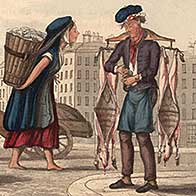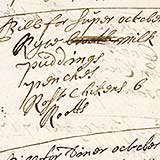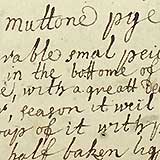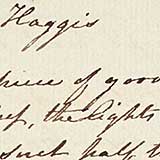
Meat, game and poultry
Until relatively recent times most Scots rarely ate flesh.
'Most Scots seldom taste the flesh of land animals; for here there are no markets. What each man eats is from his own stock … no man can eat mutton but by killing a sheep.'
— Samuel Johnson, 'A journey in the Western Islands of Scotland', London, 1775. Library reference: RB.s.969]
Although Scotland has ample supplies of wild animals and fowl, other than on feast days ordinary people were lucky if they had the occasional hen in their broth. Eating large amounts of meat, especially roasts, indicated wealth and status.
Until improved methods of agriculture were introduced in the 18th century, most domestic animals were killed off after the summer's grazing. Their meat was preserved for the winter months by salting, smoking, pickling, burying and freezing and other methods.
Alongside traditional dishes, the wealthy experimented with French methods of cookery, and curries from the East added to the cosmopolitan mix.
Venison for the servants
Meat dominated the diet of the Earl of Sutherland, his family and servants in the early 1700s.
Dunrobin Diet Book
French cooking
Mary of Guise is often credited with introducing her native cookery to Scotland following her marriage to James V in 1537.
French cooking
Preserving meat
Only the very wealthy could afford to eat fresh meat all year round.
Preserving meat
Sausages
Sausages made from pig-flesh were known in Britain from at least Roman times.
Sausage recipe
Pies
Pies are as popular now as centuries ago, probably due to their versatility.
Pies
Real India Curry Powder
Now one of Britain's favourite meals, curry was a novelty in 1798.
Curry powder
Choosing meat
John Caird's practial guide for cooks was published in 1809.
Choosing meat
Haggis
Haggis is an iconic Scottish dish, but such thrifty dishes are not peculiar to Scotland.
Haggis recipe








